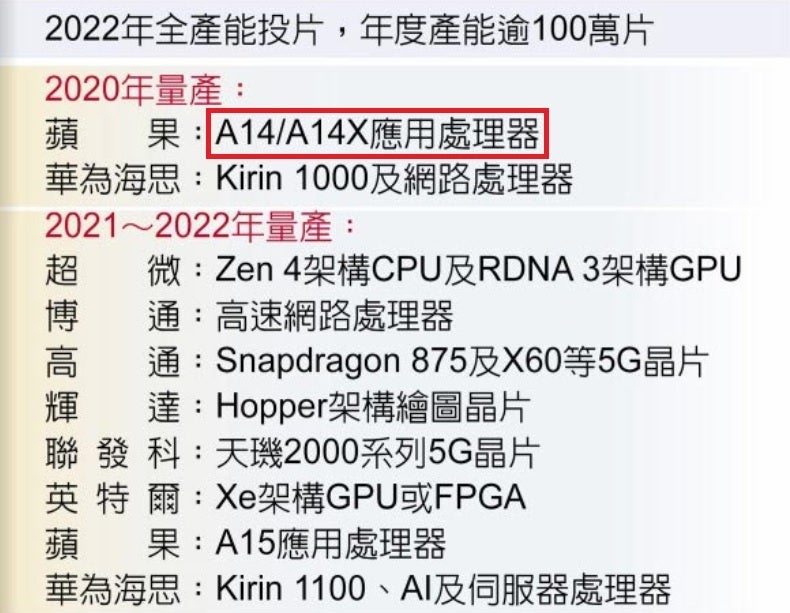Leak strongly suggests that a 5G Apple iPad Pro could arrive this year or next

Apple 'kinda-sorta' pulled a fast one when it unveiled the refreshed 11-inch and 12.9-inch versions of the iPad Pro in March. Instead of being powered by an A13X Bionic SoC like you might have suspected, Apple used the A12Z Bionic chipset instead. So what is the difference between the A12X Bionic used on the iPad Pro (2018) models and the A12Z Bionic used on the new tablets? Both are built using the same 7nm process node by TSMC and feature the same octa-core configuration (four high-performance CPU cores and four energy efficient-cores) and memory. The only difference between the two is that the A12X Bionic has seven of its eight GPU cores activated while all eight are activated on the A12Z Bionic. Other than that, both chips are basically the same.
Leaked TSMC roadmap shows 5nm A14X Bionic is scheduled for production this year
The speculation is that Apple decided against using an A13X Bionic chipset for its new premium slates because outside of the new LiDar depth sensor on the rear camera module, the 2020 iPad Pro models did not receive much of an huge update. In March, we did some speculation of our own and said that we could see an A14X Bionic chipset powering a 5G version of Apple's premium tablet. And a leak from ChinaTimes (via WCCFtech) reveals that TSMC does plan on manufacturing a 5nm A14X Bionic SoC for Apple this year.

TSMC's 5nm roadmap reveals that the A14X Bionic is scheduled to be produced this year
The world's largest contract foundry, TSMC, is starting chip production using the 5nm process mode this year. The process node relates to the number of transistors that fit in a square mm. The higher the transistor density, the more transistors inside a chip. The more transistors inside a chip, the more powerful and energy-efficient the chip is. Chips made using the 7nm process node like the A13 Bionic and the Snapdragon 865 Mobile Platform have approximately 96.5 million transistors per square mm. 5nm chips can squeeze 171.3 million transistors into a square mm.
Here is another way to look at this. The A13 Bionic SoC contains 8.5 billion transistors compared to the 15 billion inside the 5nm A14 Bionic chipset. The 5G 2020 iPhone models could very well be the first smartphones to sport a 5nm chipset. The Huawei Mate 40 series might be next, driven by Huawei's first 5nm Kirin SoC.
ChinaTimes disseminated a leak showing TSMC's 5nm roadmap for 2020 through 2022. The chips will be made using the foundry's N5 and N5+ process nodes. Apple and Huawei are the only companies expected to receive 5nm chips this year; the roadmap shows that Apple will not only be shipped the 5nm A14 Bionic this year, but will also receive the A14X chipset. Even if Apple starts receiving the latter chip this year, the release of the 5G iPad Pro has reportedly been delayed until early next year. The slate will not only support the next generation of wireless connectivity but it will also replace the LCD panel with a mini-LED display. This technology has most of the advantages of AMOLED (no backlight required) without worrying about the screen leaving behind a ghostly burn-in image.
Because there is no backlight, the color black is created on a mini-LCD screen the same way it is on an OLED display-by turning off the pixels in the appropriate area of the display. Since pixels that are turned off don't draw any power from the battery, using dark mode will be able to save some battery life.
In 2021, TSMC's 5nm roadmap includes the Qualcomm Snapdragon 875 Mobile Platform, Apple's A15 Bionic chipset, and Huawei's Kirin 1100 SoC. After that, TSMC starts testing production the 3nm process node. Chips produced using this technology will contain 300 million transistors per square mm or a 75% increase in transistor density. This means that Moore's Law, the observation made by Intel co-founder Gordon Moore that says transistor density will double every other year, is slowly getting repealed.













Things that are NOT allowed: